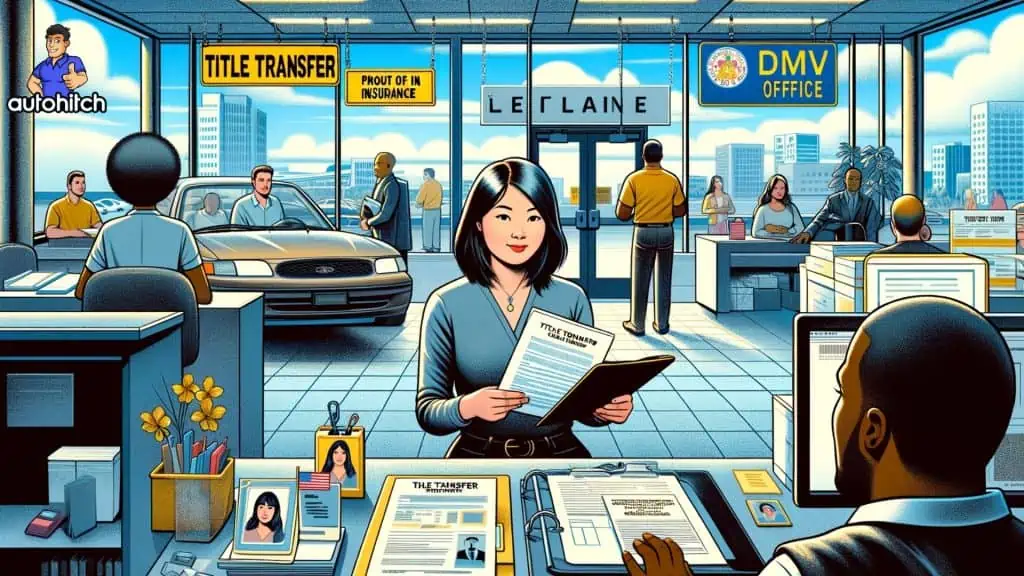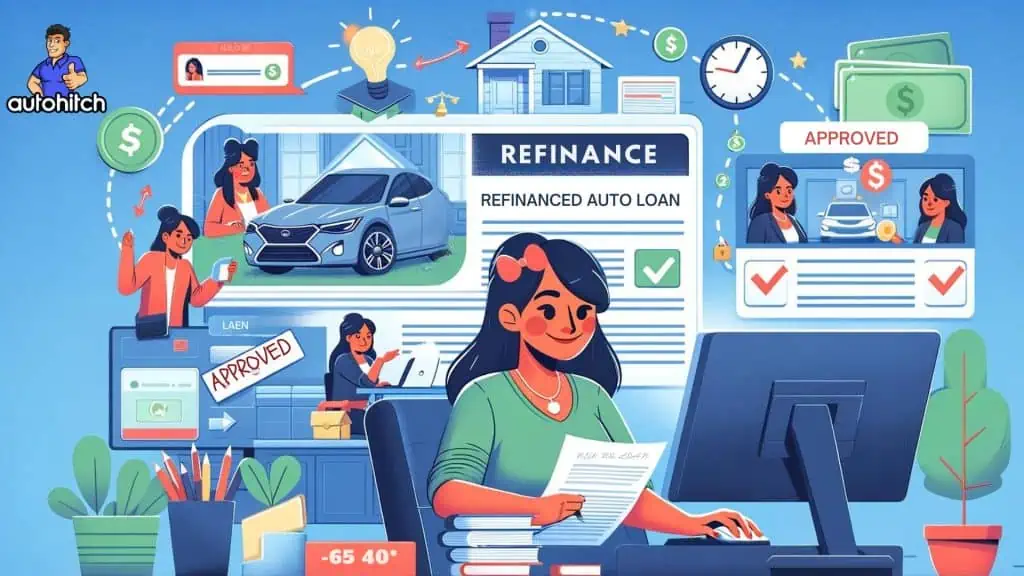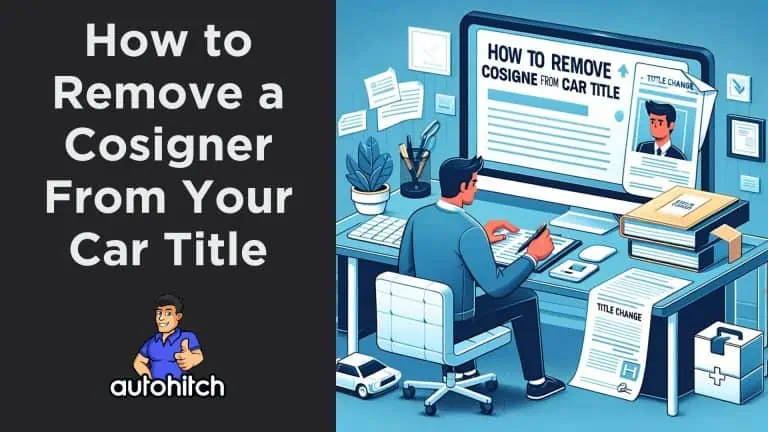Whether it’s due to improved finances, relationship changes like divorce or other reasons; there may come a time when you want to remove the cosigner from your car title.
The good news is that it is possible in most cases.
Here is a helpful and detailed table on how to remove a cosigner from a car title:
| Step | Description |
|---|---|
| 1. Pay Off the Loan | The primary way to remove a cosigner from a car title is to pay off the loan in full. Once the loan is paid, the lien on the title will be released, allowing you to remove the cosigner. |
| 2. Refinance the Loan | You can refinance the auto loan into your name only, which will allow you to remove the cosigner from the title. This requires qualifying for the loan yourself based on your credit, income, and debt. |
| 3. Transfer Title | Some lenders may allow you to transfer the title into your name only by getting the cosigner to sign a release of interest or transfer of equity form. However, the lender must agree to this. |
| 4. Sell the Vehicle | Selling the vehicle can satisfy the loan and remove the cosigner, but you’ll need their cooperation to transfer the title. |
| 5. Negotiate with Lender | You can try negotiating with the lender to remove the cosigner, especially if your credit has improved significantly since obtaining the loan. Provide proof of income, assets, and an explanation. |
*For a more detailed step-by-step guide, look further down the article.
Some additional tips:
- Act promptly once you can qualify for the loan yourself, as lenders are unlikely to remove cosigners early in the loan term
- Get any agreements with the cosigner or lender in writing
- Check your state’s requirements, as some require the cosigner’s permission to remove them from the title
- Ensure the loan is being paid as agreed to strengthen your case to the lender
The key is satisfying the loan obligation, either by paying it off or qualifying for it individually through refinancing or negotiation with the lender. Having the cosigner’s cooperation can certainly smooth the process.
Table of Contents
Why Remove a Cosigner From the Title?
There’s a difference between being listed as a cosigner on the car loan versus being listed on the actual title for the vehicle.
Even once the auto loan is paid off, the cosigner remains tied to the car if their name stays on the title.
Here are some common reasons borrowers may want to remove the cosigner from the title:
- Credit score improved – You no longer need their credentials to qualify for financing.
- Ended relationship – For example, a divorce. You don’t want an ex still listed as a joint owner.
- Protect cosigner – If you default on a future loan, it could impact their credit too.
- Sell the car – There are complications if the cosigner can’t sign title transfer paperwork.
- Full ownership – You want sole decision-making ability over the vehicle.
Key Steps to Remove a Cosigner From the Title
Follow these essential steps to remove a cosigner’s name from the car title:
1. Pay Off Existing Auto Loan
Before anything else, you first need to pay off your current auto loan if you still owe money on it. Contact your lender to get the payoff amount, then make the payment to fulfill the loan contract.
Once paid in full, the lender will send you the clean title without any liens. This is essential for removing the cosigner.
Tip: If you can’t pay the loan off immediately, consider refinancing the loan in your name only. Then use the new lender’s funds to pay off the existing loan.
2. Have the Cosigner Sign the Title Release
If the title lists both you and the cosigner’s names joined by “and,” you’ll need the cosigner to sign a release on the title. This removes their ownership interest in the vehicle.
“John and Jane Doe” -> Jane Doe would need to sign releasing her interest
However, if your names are joined by “or,” then only one owner needs to sign the title over.
Check your specific state’s DMV laws on title transfers. Many only require one current owner to release interest in transferring a car title.
3. Submit Paperwork to the DMV

Bring the signed title along with a title transfer application to your local DMV office. Standard requirements are:
- Completed Application for Vehicle Transaction form
- Applicable title transfer fees ($15-$50 typically)
- Cosigner’s signature releasing their interest
- Your signature as the buyer
- Proof of insurance on the vehicle
- Valid photo ID
Double-check for additional documentation or fees needed for your state. Submit the paperwork and request a new title to be issued in your name only.
And that’s it! In most cases, the process is straightforward. Just be diligent about following each step properly to ensure the cosigner is fully removed from the vehicle’s title.
Now, let’s get into more details on options like refinancing and what to do if complications arise.
Refinancing Your Auto Loan

Refinancing allows you to obtain a clean title from the lender without needing the cosigner’s immediate cooperation to pay off the old loan. It’s the simplest way to remove them if there are relationship issues.
Below are the typical steps to refinance an auto loan to remove a cosigner from the title:
- Apply to refinance in your name only
- Get approved for the new loan
- Use the refinance funds to pay off the current loan
- The loan contract no longer lists the cosigner
You’ll typically need good credit and timely payments on that loan to qualify on your own for a refi.
Banks will want you to demonstrate responsibility for handling loans without the cosigner’s involvement.
What If the Cosigner Can’t or Won’t Sign?
Life sometimes happens, and a cosigner may refuse or be impossible to contact if a relationship has ended poorly. Don’t panic if your cosigner is suddenly unresponsive – you still have options.
Potentially helpful article to read: Removing Name From Car Title After Divorce
If the Cosigner Is On the Title
If the cosigner’s name is also listed on the vehicle’s title along with yours, you may be able to transfer ownership without their signature:
- Check state DMV rules – Some states allow a title transfer with just one owner’s signature if the title is joined by “or” rather than “and.”
- Obtain duplicate title – You can try filing for a duplicate title with the DMV by paying fees and providing documentation. This gets a new title issued, showing you as the sole owner. Additional proof, like a death certificate, may be needed if the cosigner passed away.
- Pursue legal action – As a last resort, you may need to go to court to force the sale/transfer of the vehicle if the cosigner refuses to cooperate. This ensures you keep the vehicle.
If the Cosigner Is Only On the Loan
If the unresponsive cosigner was only a guarantor on your financing:
- Request cosigner release – Ask the lender to formally remove their liability if it was an option with your loan. Provide updated financials showing you can manage payments yourself.
- Refinance using another lender – Take out a new solo loan to pay off the existing one without the cosigner’s involvement.
- Pay extra each month – Making overpayments shortens the loan term, allowing you to obtain a clean title faster once paid off.
- Voluntarily surrender vehicle – If all else fails, surrendering the car is better than damaging your credit through repossession.
Be sure to check any loan documents for cosigner release or early termination options. Act promptly if the cosigner becomes unresponsive to protect yourself and the vehicle.
Qualifying Income Threshold for Solo Car Loan
Banks have specific debt-to-income thresholds used to approve borrowers for auto financing:
| Credit Score | Minimum Income Threshold |
|---|---|
| 740+ | 10% |
| 680-739 | 15% |
| 620-679 | 20% |
| 580-619 | 25% |
So, for example, if you earn $4,000 per month:
- Excellent Credit – Qualifies for a loan if monthly debts, including car payment, remain below $400.
Aim for financing terms that fit comfortably within 10-20% of your gross monthly income, depending on your credit score. Banks get nervous about lending beyond those ratios.
Bringing a few recent paycheck stubs when applying for the new loan also demonstrates reliable income. If self-employed, provide your latest tax returns.
Strategies to Improve Chances of Solo Loan Approval
Here are some tips to boost your odds if attempting to qualify without the cosigner after needing one initially:
- Pay all current debts on time leading up to the new application
- Pay down revolving credit card balances below 30% of their limits
- Limit new credit inquiries by only applying with 1-2 lenders
- Provide stable income verification
- Make a larger down payment to reduce the financed amount
- Consider longer loan terms (up to 72 months) to drop monthly payments
Building your credit history and having sufficient income gives lenders confidence in approving an auto loan without a cosigner needed.
Wrapping Up
I hope this guide gives you clarity on exactly how to go about removing a cosigner from the title of your vehicle. The most important steps again are:
- Pay off the current auto loan
- Obtain cosigner release signature on title
- Submit paperwork at the local DMV
And examine options like refinancing if you need to take out a new loan.
Vehicles are a major purchase for most people. Removing lingering financial connections gives freedom and flexibility down the road. Life moves fast, so take control where you can!
Let me know in the comments if any other questions come up.



